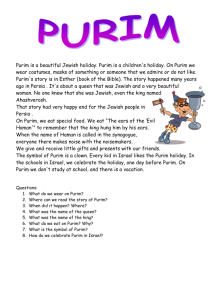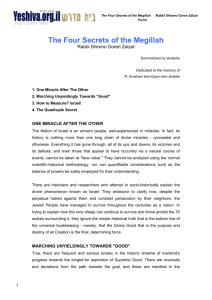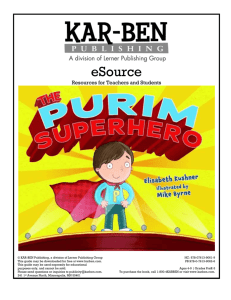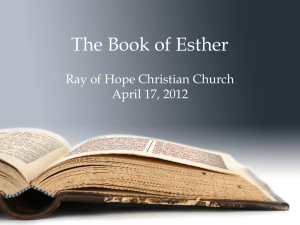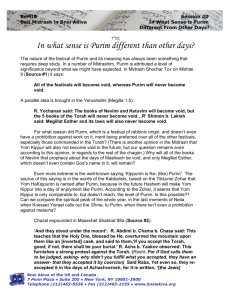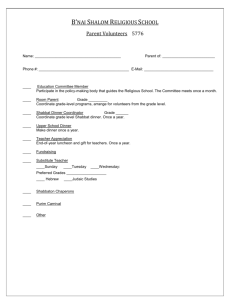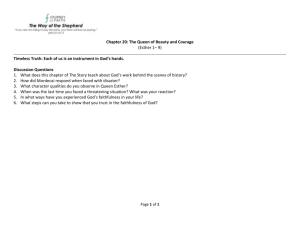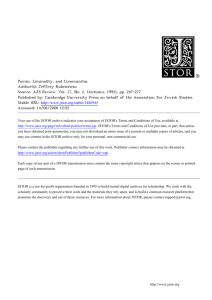Purim 5771/2011 Kit Word Document
advertisement
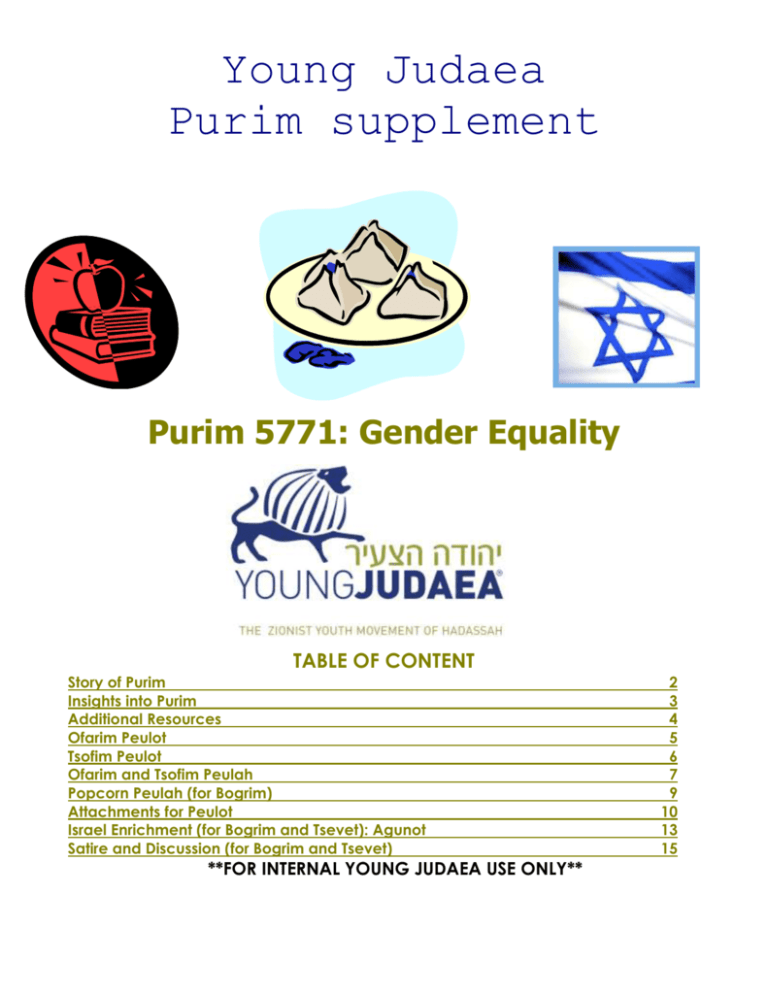
Young Judaea Purim supplement Purim 5771: Gender Equality TABLE OF CONTENT Story of Purim Insights into Purim Additional Resources Ofarim Peulot Tsofim Peulot Ofarim and Tsofim Peulah Popcorn Peulah (for Bogrim) Attachments for Peulot Israel Enrichment (for Bogrim and Tsevet): Agunot Satire and Discussion (for Bogrim and Tsevet) **FOR INTERNAL YOUNG JUDAEA USE ONLY** 2 3 4 5 6 7 9 10 13 15 Purim 5771 Gender Equality Story of Purim The Story of Purim can be found in the Megilat Esther, located between Ecclesiastes and the Book of Daniel. The story of Purim takes place in modern day Persia, or as is described a kingdom that stretched from “Hodu (India) even unto Cush (Ethiopia),” being ruled by King Ahashverush. The story begins with Ahashverush’s queen, Vashti, refusing to “appear in her beauty” before Aheshverush’s feast. Upon her refusal, to set an example of her, Ahashverush takes away Vashti’s status as queen and seeks a new queen. A local and wise Jew, named Mordechai, recognizes that Esther, his orphaned cousin, is beautiful and encourages her to win Ahashverush’s approval to become queen. King Aheshverush becomes thoroughly impressed by Esther’s beauty and makes her queen. Afterwards, Mordechai overhears two guards plotting to kill the king and told Esther. Esther promptly warned the king and Ahashverush had the two traitors executed. After this, Haman, a member of the court, is advanced to the king’s highest advisor, and placed “his seat above all the princes that were with him.” When Mordechai refuses to bow down to Haman, Haman is infuriated and develops a plot to kill all the Jews in the kingdom. He manipulates the king into signing a decree to slay all the kingdom’s Jews and has gallows built for Mordechai’s execution by hanging. When Mordechai learns of Haman’s plot, he grieves and beseeches Esther to use her influence to reverse the order. Esther disobeys a rule of the court by appearing without invitation, which is punishable by death, to speak to the king. The king allows her appearance and asks that he and Haman would be attend a banquet for her to host. The king accepts the request. That night, the king cannot sleep and has his royal records read back to him. He realizes he has not honored Mordechai for informing Esther of the attempt to kill him and he orders Mordechai to be honored greatly in public. Later at Esther’s feast, the king asks Esther if there is anything she would like from him. At this point, Esther reveals how Haman has tricked him into ordering the slaughter of the Jews. Ahashverush orders Haman to be hung from the gallows he had built for Mordechai and issued a new decree that allowed the Jews to prevent their slaying. Purim Insights: Power and Equality There are many aspects of the Purim story that continue to inspire today. Part of the power of the story is that it is the only book in the Tanach that does not mention God once. There is a commentary in the Mishnah (Mishlei 9) that when the Messianic Age begins, Jews will only celebrate two holidays: Yom Kippur and Purim. Yom Kippur because it remains the holiest day of the calendar and Purim, because it commemorates when the Jewish People began acting out God’s will without direct, divine intervention. There are many different ways of approaching the Purim story, for now we will focus on the role of gender relations and women in this. The story is really of two women: Vashti and Esther. Vashti, not Jewish, begins the story’s sequence of events by refusing to appear naked in front of the court. Her refusal to take part in such an objectification is a powerful protest, asserting her individuality as more than just a possession of the king. The protest is so powerful that Ahashverush’s advisers urge him to remove her from her post because they fear that her actions will inspire more women to make themselves, “contemptible in their husbands eyes. (Esther 1:17)” Vashti may be cited as a biblical feminists who uses passive resistance to make her case. The second woman is of course, Esther (which in Hebrew is Hadassah). Esther also asserts herself as a leader and as a woman, but differently. Esther recognizes her unique role in influencing the king to save her people. Her moment of courage arises when she bravely faces the possible punishment of death when she goes before the king uninvited. Both Vashti and Esther break the rules. But whereas Vashti protests her treatment as a woman by refusing appearance, Esther fights the treatment of the Jews by appearing uninvited. Both Vashti and Esther stand out as women of principle, which is more than can be said about the men, with the exception of Mordechai. However, what differentiates them is that Esther serves as a role model not as a women’s rights advocate, but as an advocate for justice. She is a cornerstone of gender equality in Judaism because she went against society’s norms and affected change, not acquiescing to be a man’s piece of property. Additional Resources on Purim and Gender Equality in Judaism: Please use any of the listed resources to learn more about Purim or Women in Judaism: Helpful Purim Websites: Jewish Reconstructionist Federation: http://jrf.org/purim-resources Union of Reform Judaism: http://urj.org/holidays/purim/ Chabad: http://www.chabad.org/holidays/purim/default_cdo/jewish/Purim.htm Orthodox Union: http://www.ou.org/holidays/purim/purim_is_forever Jewish Theological Seminary: http://www.jtsa.edu/About_JTS/JTS_Stories/JTS_Celebrates_Purim.xml Purim Books: Esther: A Modern Commentary, Translation and Commentary by Leonard Kravitz and Kerry Olitzky Here Come the Purim Players! Barbara Cohen, Illustrated by Shoshana Mekibel Helpful Women in Judaism Websites and Organizations: http://jwa.org/teach/livingthelegacy www.Hadassah.org www.WomenoftheWall.org.il www.On1foot.org (go to browse source sheets and search “Women Empowerment”) Purim Peulah 5771: Ofarim By Andrew Fretwell Age of Chanichim: 2nd -5th Grade Goal: To do the four mitzvot of Purim Essential Question/s: How do we celebrate Purim? Jewish Values Addressed: Simcha, Limmud Torah, Shalsheret Hakabbalah Assessment: Chanichim will together fill out the Purim “Checklist” Time: 45 minutes Materials: A. Purim Story Mad Libs (attached) B. Blanket or towel to create “stage” for finger puppets C. Finger puppet materials (cheap gloves, scissors, lace, googley eyes, yarn, markers, etc) D. Purim Mitzvot “check list” (description attached) E. Mishloach Manot materials (Small plastic bag, Candy, thotchkes, small cards) F. Hamentaschen and snacks Implementation Trigger/Explanation-(5 minutes): “Hello. Who knows what Jewish Holiday is coming up? That’s right, Purim! Purim is one of the most fun and happiest Jewish holidays all year! There are four mitzvoth we are all supposed to take part in as a part of Purim and we’re going to do all of them together! Who’s ready to begin?? All right, let’s start! Step 1: 1 Mitzvah- Telling of the Mad Libs/Story of Purim (15 minutes) Please use the attached Mad Libs sheet to retell the story of Purim, with madrichim acting out the play (finger puppets attached). Step 2: 2nd and 3rd Mitzvot - Mishloach Manot (15 minutes) A. Explain the tradition of spreading joy through giving mishloach manot to our friends and family, as well as those in need. Explain that as part of that, we’re going to make mishloach manot to bring up to their families and another for Israeli soldiers who are away from their families. Note: that you need to plan how to pay for shipping these packages. B: Give out materials for making mishloach manot and help chanichim make them (2 packages per chanich/a). Step 3: 4th Mitzvah - Purim Party (10 minutes) Hand out Hamentaschen, other candies and snacks to everyone and conclude the activity with a Purim party! Don’t forget to play Israeli music! Sikkum: Review the Purim Checklist with the whole group. At each mitzvah, ask the group if they did this mitzvah together and then check it off. As each chanich/a leaves, give out a little “Purim mitzvah check list” with information on the back for the next event. Purim Peulah 5771: Tsofim By Andrew Fretwell Age of Chanichim: 6th - 8th Grade Goal: To do the four mitzvot of Purim Essential Question/s: How do we celebrate Purim? Jewish Values Addressed: Simcha, Limmud Torah, Shalsheret Hakabbalah Assessment: Chanichim will together fill out the Purim “Checklist” Time: 45 minutes Materials: A. Purim Story Mad Libs (attached) B. Purim Mitzvot “check list” (description attached) C. Mishloach Manot materials (Small plastic bag, Candy, thotchkes, small cards) D. Hamentaschen and snacks Implementation Trigger/Explanation-(5 minutes): “Hello. Who knows what Jewish Holiday is coming up? Who knows what we do on Purim? There are four mitzvoth we are all supposed to take part in as a part of Purim and we’re going to do all of them together! Who’s ready to begin?? All right, let’s start! Step 1: 1 Mitzvah- Telling of the Mad Libs/Story of Purim (15 minutes) Please use the attached Mad Libs sheet to retell the story of Purim. Ask for different volunteers (of the chanichim) to act out different parts of the story as it is being told. Step 2: 2nd and 3rd Mitzvot - Mishloach Manot (15 minutes) A. Explain the tradition of spreading joy through giving mishloach manot to our friends and family, as well as those in need. Explain that as part of that, we’re going to make mishloach manot to bring up to their families and another for Israeli soldiers who are away from their families. Note: that you need to plan how to pay for shipping these packages. B: Give out materials for making mishloach manot and help chanichim make them (2 packages per chanich/a). Step 3: 4th Mitzvah - Purim Party (10 minutes) Hand out Hamentaschen, other candies and snacks to everyone and conclude the activity with a Purim party! Don’t forget to play Israeli music and do/teach Israeli rikud! Sikkum: Review the Purim Checklist with the whole group. At each mitzvah, ask the group if they did this mitzvah together and then check it off. As each chanich/a leaves, give out a little “Purim mitzvah check list” with information on the back for the next event. Purim Peulah 5771: Ofarim and/or Tsofim By Yael David, Livingston, NJ Age of Chanichim: 2nd - 8th Grade Goals: To reinforce the story of Purim. For the chanichim to explore their Jewish identity. To enjoy some yummy hamentashens TO HAVE FUN! Jewish Values Addressed: Simcha, Limmud Torah, Shalsheret Hakabbalah Essential Question: What is Purim? Time: 75 minutes Materials: Sign in sheets and Pens Candy (one for each OT) Music Box of hamentashens Newspapers Trigger: Costume contest! (15 minutes) Ask all the dressed up kids to think of a name for their character (Cinderella, ninja turtle, etc.) and to think of 3 hobbies of their character (can be silly). Once they have their name and hobbies, they will come up one by one and tell everyone else (who should be sitting on the floor) their names and hobbies. At the end we will pull a "but EVERYONES a winner in Young Judaea” and give everyone a piece of candy. Implementation Part 1: The Dares (20 minutes) The OT’s will sit in a circle, and pass around the newspaper full of dares on each layer. Israeli music will be playing as they do this. When the music stops, the person holding the newspaper has to rip off a layer and do the dare. This will continue until all OT’s complete a dare. The core will be a box of oznei haman (hamentashens) =] Dares: 1. Do the chicken dance. 2. Sing your favorite song. 3. Run around the room twice. 4. Do 10 jumping jacks. 5. Make your favorite animal noise. 6. Show us your favorite dance move. 7. Act out your favorite TV show. 8. Act out the teacher you hate the most (from school). 9. Pretend you just ate a VERY hot pepper. 10. Do 10 izzy-dizzy’s and try to run to the other side of the room. Implementation Part 2: Charades (15 minutes) Give each kid a different character that they would know from TV, history, or pop culture. Not each kid needs to get one. Only about 3 or 4 give or take.(i.e: Joe Jonas, Miley Cyrus, George Washington, Spongebob, Derek Jeter, Dora the Explorer) Then ask the kids to come up and act out their character, like in a game of charades (they can speak though). Sikkum: Skit (15 minutes) Pick one kid for each character in the Purim story: Queen Vashti, King Achashverosh, Queen Esther, Mordechai, Haman, a plotter, and the King’s helper. One of the Bogrim will narrate the story, and when there is a “pause” the kids will act out what was just narrated. Queen Vashti would not listen to her husband, King Achashverosh (of Shusan – Persia) and do what he said. PAUSE. So the King had Vashti expelled from the kingdom (and probably killed her). PAUSE. King Achashverosh then held a contest for all the young women of Shushan so he could choose his new Queen. ASK ALL THE GIRLS TO DISPLAY THEMSELVES TO THE KING. A woman named Hadassah, who changed her name to Esther so they would not know she was Jewish, won the contest and was the new Queen of Shushan. PAUSE. Her cousin, Mordechai who had been taking care of her heard two men talking of a plot to kill the King. PAUSE. He informed the king, and it was recorded that he had saved the king’s life. PAUSE. Later on, the king appoints Haman as his right hand man who had a plot to kill all of the Jews in shushan. PAUSE. He held a lottery to pick a date to kill all of them – which was the 13th of Adar. When Esther finds out about this, she, and many other Jews fasted for 3 days to pray to G-d to save them. PAUSE. Esther invites Haman and the King to a feast and at the end invites them to a 2nd one. PAUSE. That night the King had troubles sleeping and had men read his book of records to him. They had come across the record of Mordechai saving the King’s life and the King realized that Mordechai must be recognized. PAUSE. At the 2nd feast, Esther reveals that she is Jewish, and that Haman was plotting to kill all of her people. PAUSE. On the 13th of Adar, Haman and his 10 sons are killed. Sicha: (10 minutes) In the sicha, relate the game of charades to how Esther had to act differently and couldn’t be herself. Ask the kids how they felt when they couldn’t act like themselves. 1. How did you feel not being yourself when you had to do a “dare”? 2. Was it hard to make people believe you were someone else during charades? 3. What was it like to act like somebody else during the skit? 4. What are some things that describe you? (Have a few kids share.) 5. Would you still be YOU if you didn’t have those characteristics? 6. Do you think it was hard for Esther to pretend that she wasn’t Jewish? 7. Do you think she still had the same personality without her Judaism? 8. For the kids that go to public school – do you sometimes pretend that you aren’t Jewish? Why/why not? 9. Is it sometimes hard to be Jewish in places where there aren’t many Jews? 10. Do you feel more comfortable when you are in a place with a lot of Jews? Why/why not? What kind of place would this be? Sikkum: Even though Purim is a time to eat yummy hamentashens and BOO at Haman’s name, it’s also important to remember all of the ideologies behind these symbols. We have to remember a hero, Esther, who saved our people, and all that she went through to do so. She hid her Judaism from the King and from all of Shushan because of anti-Semitism and the dangers of being Jewish at the time. Unfortunately, we still see this today. So where can we feel comfortable and just be ourselves? (YJ?!) Popcorn Peulah Courtesy Omer Givati, Shaliach to Northeast Young Judaea Rent any of the following Jewish/Israeli films (all are available on Netflix) to show as part of a Purim program in your community. Each of these movies is either related to Purim or the theme of empowered Jewish women. Blessed is the Match: The Life and Death of Hannah Senesh 2008, Documentary – 85 Minutes Joan Allen narrates this riveting portrait of Hungarian poet Hannah Senesh, a remarkable woman who risked her own life to parachute behind enemy lines -- enduring capture, torture and, ultimately, death -- to rescue Jews from Nazi persecution. Ahead of her time and on a mission of incredible odds, Senesh ultimately became a martyr in Israel, evoking the spirit of warrior-heroine Joan of Arc and earning the gratitude of those she saved. Hasodot (The Secrets) 2007, Rated R – 127 Minutes At an all-female seminary in the Israeli holy city of Safed, brilliant Naomi (Ania Bukstein) befriends rebellious Michelle (Michal Shtamler), but their friendship is tested when they meet a sickly Frenchwoman named Anouk (Fanny Ardant) who needs their help. Risking expulsion, Naomi and Michelle embark on a journey of self-discovery as they secretly study kabbalistic texts, learning cleansing rituals that will aid the mysterious Anouk. A Woman Named Golda 1982, Made For TV Movie – 199 minutes This made-for-TV biopic stars Emmy winner Ingrid Bergman as Golda Meir, a Russian-born Jew raised in Wisconsin who served as prime minister of Israel from 1969-74 -- one of the most turbulent periods in the country's history. Oftencalled the Iron Lady of Israel, the fiercely determined Meir led the nation through the 1973 Yom Kippur War and the massacre of 11 Israeli athletes and coaches at the 1972 Summer Olympics in Munich, Germany. Attachment 1 (Ofarim and Tsofim): Purim Mad Libs The story of Purim is a great tale. There is a beautiful, courageous heroine, an all powerful king, a loyal cousin, and a villain who gets foiled by his own evil plans. Read and enjoy! *************************************************** In the city of (Name of Place), Vashti, the (Noun) of Persia, refuses to (verb) the order of the King of Persia, Ahashverush, to appear before his (noun). The King then searches the country for a (adjective) queen. From among hundreds of applicants, Esther, cousin of Mordechai the Jew, is (verb). The King's (noun) was an evil man named Haman. Haman hates the Jews and decides to (verb) them. He convinces King Ahashverush to issue an (noun) which orders the destruction of all Jews in the land. Mordechai pleads with Esther to save the Jewish people by (verb/participle, ends in-“ing”) to the King. At the risk of her (noun), Esther appears before the King without being summoned by him. She reveals her own Jewish (noun) to the King and reveals Haman's (adjective) plot. The King is outraged at Haman, and he issues a decree to make Haman the (noun) of his own infamous plot. Haman and his sons are (verb), and the Jews are (verb). **Please note, you may need to adjust verb tense here, specifically to make sure certain words end in “ing” or “ed” and such. Please read this over before the peulah.** Attachment 2 and 3 (Ofarim and Tsofim): Purim Mitzvah Check List model for poster and model for hand-out PURIM MITZVAH CHECKLIST Hear the Purim Story Make Mishloach Manot for loved ones Make Mishloach Manot for those in need Purim Feast or Party! PURIM MITZVAH CHECKLIST I… Heard the Purim Story Made Mishloach Manot for my family Sent Mishloach Manot to a food shelter/Israeli soldiers Had a Purim Party! WITH YOUNG JUDAEA! Israel Enrichment: Saving women from the 'Chain' According to halakha and contemporary Israeli law, a Jewish woman must receive a religious bill of divorce in order to remarry. By Sarah Breger Yesterday, Jews all over the world commemorated Ta'anit Esther (the Fast of Esther), the day on which the heroine of the Purim story took her fate and that of her people into her own hands. For the past few years, Ta'anit Esther has also been marked as International Agunah Day - an occasion to remember the plight of those who are "chained" to spouses who refuse to grant them a divorce. According to halakha (traditional Jewish law) and contemporary Israeli law, a Jewish woman must receive a religious bill of divorce (a get) in order to remarry. In the absence of a get, any child of a future relationship will be a mamzer - loosely translated as "bastard" - and will be stigmatized under Jewish law. A woman can likewise be recalcitrant, but there are numerous loopholes for men that can free them of the consequences of having a recalcitrant wife. Israeli citizens do not have the luxury of considering the issue of agunot a "religious" or "arcane" problem. All Israelis are required to marry and divorce within a religious framework, so that even the most secular Jew is affected. (Even Israelis who get married in Cyprus must be divorced according to Jewish law if they separate.) Unfortunately, despite the hard work of various organizations, there has not been a marked improvement in the status of agunot. Rabbis still do not pursue solutions that are possible within halakha, and dayanim (religious judges) continue to claim that the problem is not widespread. The number of agunot is a highly contested issue, with the rabbinate in this country claiming only several hundred in a given year, while some women's organizations claim several thousand. While this is disheartening, there is one means for sidestepping the problem that has been recognized by the majority of rabbinic and legal authorities - the signing of a halakhic prenuptial agreement. This preventive measure, taken by both bride and groom, threatens either party with serious monetary consequences if he or she refuses to grant or to receive a get in the event of the marriage's breakdown. Although this does not provide an answer for women who are currently agunot, it can prevent the problem before it arises. The "prenup" has been embraced by rabbinical authorities in the United States. In fact, the Rabbinical Council of America, the centrist organization of Orthodox rabbis in North America, insists that none of its members officiate at a wedding unless a proper prenuptial agreement has been signed. Some American rabbis even require couples to state publicly under the huppah that a prenup has been signed. Several variations of the prenuptial document have been drafted by different religious institutions. One option, the Agreement for Mutual Respect, put forward by the Council of Young Israel Rabbis in Israel, obligates the recalcitrant person, upon being asked for a divorce, to support the spouse with up to half of his/her net income, until it is granted. In this specific agreement, the recalcitrant party can request up to three marital counseling sessions, but after that the agreement goes into effect. The contract, signed prior to the wedding in a rabbinic court, secular court, or even before a general notary, is a legal document that will be enforced by the courts. Perhaps most important, this document has been publicly approved by the director of Israel's rabbinical courts, Rabbi Eliyahu BenDahan. Nonetheless, in Israel, this preventive measure, though available, remains largely unused. Some couples balk at signing such a document before their wedding day, saying they are too much in love to sign something they will never need to use. But a great many Israelis are simply not aware that it exists. Sadly, this is because rabbis, teachers and lay leaders do little to actively encourage the signing of the prenuptial agreement. With 9,963 divorces among Jews in 2006 in Israel, the subject is clearly not irrelevant. Bringing legal considerations into the wedding ceremony is not a foreign concept for traditional Judaism. The ketubah, after all, is a legal document about death and divorce. Similarly, the prenup should be viewed as an insurance policy - a sensible way to be prepared for something you hope and expect will never happen. It is imperative that the prenuptial agreement become standard procedure in Israel. As more couples sign, social stigma will vanish and it will become a normal part of the marriage ceremony. The rabbinate should actively promote the agreement when a couple goes to register for marriage. Information about the prenup should be part of the curriculum in premarital courses required of men and women, and should be publicized through schools, youth movements and the army. Lawyers who specialize in family law can do much to encourage couples to sign by explaining the agreement's legal implications. The prenup is only a partial solution. A deadbeat won't be affected by the monetary fine. A wealthy, vindictive spouse may not care about it. And to repeat, the document does not alleviate the problem of existing agunot. It does, however, set the tone for a marriage of equality and mutual respect. Moreover, it is the best solution we have at present to prevent future agunot and must therefore be embraced. In this holiday of nahfoch-hu (topsy- turvy-ness), it is time for Israeli society to take bold steps to prevent the tragedy of future agunot. Sarah Breger, a 2007-08 Dorot Fellow, is a volunteer with Young Israel Rabbis in Israel. Satire and Discussion: Purim Sicha (For Bogrim and Tsevet) Feel Free to use this satirized article, from the Makom division of the Jewish Agency for Israel, and the sicha (discussion prompts), from former Young Judaea Central Shaliach, Emil Zaidman, as part of a longer Purim Peulah. Directly From the Jewish Agency's Makom web site: MAKOM exclusive: Purim or Yom Ha'atzmaut? EXCLUSIVE: "Documents have recently reached the MAKOM offices, that should give the entire Jewish world cause for concern. A leaked draft of the Jewish People Planning and Policy Positions on People hood Institute (JPPPPPI) talks of plans to abolish celebrations of Israel's Independence Day (Yom Ha'atzmaut), and co-opt Purim instead. All the more disturbing is that no one - neither in the JPPPPPI, not the Jewish Agency, nor the Israeli government - will come out and publically deny these rumors. "Let's face it," sigh sources in the Jewish Agency's Education Department, "Yom Ha'atzmaut celebrations are particularly lame. I mean, how much more felafel can you eat?" Sources close to the JPPPPPI explain their recommendation in a more positive way: "Purim is the festival of revolutions, the ultimate secular festival where God isn't even mentioned once, and it's a festival of power. It's the perfect festival to celebrate the establishment of the State of Israel." Even the incoming Minister for Foreign Affairs, Avigdor Doberman, is a great fan of the Book of Esther. "Did you read how many Iranians we kill at the end of the story?" enthuses one of his aides. Is this the end of 60 years of blue and white balloons? Is Israel going to politicize yet another area of Jewish practice? Or should we celebrate the conflation of Israel's Independence Day with the only Jewish festival that encourages us to get so drunk we can't tell the difference between Obama and Ahmedinijad?" Accompanying Sicha: This is indeed the first time in our history where we meet the modern form of Anti-Semitism. Hatred of the Jews not because of some tribal regional conflict, but because they are "different from the rest of us". Are we still different? Purim is not the first time in our tradition where we have a feminine hero, but it is the first time where the feminine hero is a member of an inter-faith family? How does this affect our views of assimilation (wait until we get to Shavu'ot and Megilat Ruth!) G-d's name is not mentioned at all in the entire Megillah, it all man made history, and still, it is fascinating, true and once again we come out victorious - Meaning that in some cases - we can do pretty well even without him (or her). Is this an important development for the Jewish People? The mitzvah on Purim to drink until you can not tell the difference between blessed and evil, means that maybe in life, there are many similarities between good and evil and maybe they are not so different from one another? At the end of the megillah there is a whole chapter on how the Jews where not satisfied with one day of "getting against" their enemies, but demanded and received another day of slaughter and revenge. Does this show that even then, we did whatever we wanted and we thought necessary without paying much attention to international media and the general feelings of the international community? B’Hatzlacha (good luck) planning and running your Purim Program! -The National Mazkirut and Education Staff of Young Judaea! Young Judaea Manager of Youth Leadership and Education, Andrew Fretwell Merakez Chinuch L’Bogrim (Bogrim Programmer), Jacob Schneider Merakezet Chich L’Ofarim v’Tsofim (Ofie—Tsofie Programmer), Naomi Mallin Young Judaea 50 West 58th Street New York, NY 10019 (212) 303-4570
